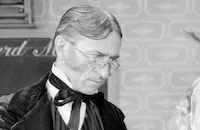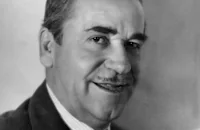The Girl of the Golden West

Brief Synopsis
Cast & Crew
Robert Z. Leonard
Jeanette Macdonald
Nelson Eddy
Walter Pidgeon
Leo Carrillo
Buddy Ebsen
Film Details
Technical Specs

Synopsis
In Nineteenth century California, orphan Mary Robbins and her Uncle Davey cross the mountains into California and meet Father Sienna, who tells them about a bandit known as Ramerez. Ramerez, a white man who was reared by Indians, hears young Mary singing and is intrigued by her. Years later, Mary runs the Polka Saloon in the town of Cloudy Mountain. Sheriff Jack Rance, is in love with Mary, and has just given her a piano for her birthday, As "The Professor," an alcoholic old barfly plays, Mary sings for her customers, all of whom adore her. The next day, she goes by stage across the moutains to Monterey to see Father Sienna. While crossing the mountains, the coach is stopped by Ramerez, who is immediately attracted to the now grown Mary, and let's them pass unharmed. In Monterey, Mary learns that Father Sienna has been receiving mysterious, anonymous contributions for the church. The next day, as Mary sings the "Ave Maria" at Mass, a hidden Ramerez sees her and later overhears the Governor inviting her to a ball. The next night, using a uniform he has stolen from Mary's appointed escort, "Lieutenant Richard Johnson," Ramerez poses as the officer and calls for Mary to drive her to the ball. On the way, his attentions become too arduous and Mary slaps him, then drives off to the ball by herself. At the ball, Ramerez apologizes to Mary and they dance, then he rushes off, when the real Lieutenant Johnson arrives and reveals what has happened to him. After Ramerez leaves, Rance tells Mary that he has been trying to catch the bandit Ramerez and plans to trap him by letting it be known that a huge shipment of gold is being stored in the Polka. Back in Cloudy Mountain, Ramerez enters the Polka and is surprised to see Mary. Because he is a stranger, Rance is suspicious, and, although Mary pretends to be an old friend of the stranger, Rance remains suspicious and tells him to leave town. Mary invites Ramerez to her cabin for dinner that night and he comes, but to throw Rance off his trail, Ramerez's friend "Mosquitto" pretends to be the bandit and rides out of town, chased by Rance's posse. A short time later, at the bandits' camp, Nina Martinez, Ramerez' jealous sweetheart, learns that he has fallen in love with Mary and goes to Rance to tell him where Ramerez is. Rance and his men then go to Mary's cabin and, while Ramerez hides outside, Rance tells Mary everything. Mary is hurt and angry when she learns the truth about the man with whom she has fallen in love. She then hears shots outside and she opens the door to find a wounded Ramerez. She quickly hides him in the cabin's loft so that Rance will not find him, and when Rance returns, she denies knowing where Ramerez is. When blood drops onto Rance's hand from Ramerez' wound, however, the bandit is forced to come down and face the sheriff. Mary then pleads with Rance to save Ramerez' life and Rance agrees to cut cards to decide his rival's fate. Mary wins, but when Rance sees that she has cheated, the only way she can save Ramerez's life is by promising to marry Rance. He then allows Ramerez time to ride away. Some time later, in Father Sienna's chapel in Monterey, Mary prepares for her wedding. She hears Ramerez singing to her and he comes to see her one last time. She begs him to go away, but when Rance realizes that Mary truly loves the bandit, he tells Father Sienna that he has put the wrong name in the bridal book. Finally, Ramerez and Mary cross the mountains together.

Director

Robert Z. Leonard
Cast

Jeanette Macdonald

Nelson Eddy

Walter Pidgeon

Leo Carrillo

Buddy Ebsen
Leonard Penn
Priscilla Lawson
Bob Murphy

Olin Howland

Cliff Edwards

Billy Bevan
Brandon Tynan

H. B. Warner

Monty Woolley

Noah Beery Sr.
Bill Cody Jr.
Jeanne Ellis
Ynez Seabury
Victor Potel
Nick Thompson
Tom Mahoney
Phillip Armenta
Chief Big Tree
Russell Simpson
Armand "curly" Wright
Pedro Regas
Gene Coogan
Sergei Arabeloff
Albert Morin
Joe Dominguez
Frank Mcglynn

Cy Kendall

E. Alyn Warren
Francis Ford
Hank Bell
Dell Henderson
Frank O'connor
Ronnie Rondell
Joe Popkin
Bob Pierce
James Farley
Edward Peil Sr.
Hal Leseur
Harry Semels
Walter Bonn
Richard Tucker
Virginia Howell
Carlos Ruffino
Rodolfo Hoyos
Forbes Murray
St. Luke's Choristers
Fr. Machaias Lani's Choir
Crew
Adrian
Leo Arnaud
Johann Sebastian Bach
James Brock
Raymond Chace
Murray Cutter
Isabel Dawn
Boyce Degaw
Zari Elmassian
Cedric Gibbons
Robert A. Golden
Charles Gounod
John Greer
W. Donn Hayes
Eddie Imazu
Gus Kahn
Lou Kolb
Fred Lane
Reginald Leborg
Robert Z. Leonard
Franz Liszt
Paul Marquardt
Oliver T. Marsh
Wm. Anthony Mcguire
Mike Mclaughlin
John M. Nickolaus
Merrill Pye
Leonid Raab
Albertina Rasch
Sigmund Romberg
Carlos Ruffino
Douglas Shearer
Charles Stallings
Herbert Stothart
Slavko Vorkapich
Edwin B. Willis
Ted Wurtenberg
Z. Yaconelli
George Yohalem

Videos
Movie Clip


Trailer
Film Details
Technical Specs

Articles
The Girl of the Golden West - THE GIRL OF THE GOLDEN WEST - THE GIRL OF THE GOLDEN WEST
Based on a 1905 play by David Belasco, The Girl of the Golden West had been previously filmed three times before MGM decided it was the perfect vehicle for its hottest duo. The first version was a 1915 film by Cecil B. DeMille, the second one appeared in 1923, directed by Edwin Carewe, and the third version starred Ann Harding and was released in 1930. The Girl of the Golden West was originally set to music from an opera by Puccini (Belasco also penned the drama that would become Puccini's famed Madame Butterfly).
Yet, in 1938, an entirely new score was created for the Eddy and MacDonald version. None of Puccini's music was used. This time, Sigmund Romberg, the operetta composer who had co-written the play on which the popular Maytime (1937) was based, and lyricist Gus Kahn teamed up to create the memorable tunes. Curiously, The Girl of the Golden West was short on duets, only allowing the stars a few bars together at the end of "Mariachie" and a short reprise of "Senorita". Some might claim this was the best approach, considering reports of feuding between the two stars. Apparently MacDonald originally wanted Allan Jones, her co-star from The Firefly (1937) to play the role, reasoning that he'd be more believable as the masked, Mexican bandit than blond Eddy. In the end, Eddy got the part, and the story was changed, adding flashbacks at the beginning to set him up as the adopted son of a Mexican outlaw.
Here's some amusing side notes about The Girl of the Golden West. It was rumored that Joan Crawford had wanted to play the female lead, hoping to show off her singing abilities. Also, had Jeanette MacDonald agreed to it, she and Eddy might have been paired in a Robin Hood operetta. But MGM scrapped the idea when Warner Bros. beat them to the punch with 1938's The Adventures of Robin Hood starring Errol Flynn and Olivia de Havilland.
Look for lots of famous faces in The Girl of the Golden West. Walter Pidgeon plays the sheriff. H.B. Warner appears as a priest. Buddy Ebsen, one of the best song and dance men around at that time, displays his unique talents. Unfortunately, due to the excessive length, Ray Bolger (The Wizard of Oz's Scarecrow) had his musical scenes cut for time.
Director: Robert Z. Leonard
Producer: William Anthony McGuire
Screenplay: Isabel Dawn, Boyce DeGaw, based on the play by David Belasco
Cinematography: Oliver T. Marsh
Editor: W. Donn Hayes
Art Direction: Cedric Gibbons, Eddie Imazu
Music: Sigmund Romberg
Cast: Jeanette MacDonald (Mary Robbins), Nelson Eddy (Ramerez/Lt. Johnson), Walter Pidgeon (Sheriff Jack Rance), Leo Carillo (Mosquito), Buddy Ebsen (Alabama).
BW & C-122m. Closed captioning.

The Girl of the Golden West - THE GIRL OF THE GOLDEN WEST - THE GIRL OF THE GOLDEN WEST
Quotes
I hope I'll see you again sometime. Yeah?- Ramerez
I hope I'll see you again sometime too. Dangling on the end of a rope!- Mary Robbins
Trivia
Belasco's play originally opened in New York on 14 November 1905.
Notes
Giacomo Puccini wrote an opera based on the David Belasco play entitled La Fanciulla del west, with a libretto by Guelfo Civinini and Carlo Zangarini, that had its premiere in New York on December 10, 1910. According to a news item in Hollywood Reporter on December 18, 1936, when M-G-M purchased the rights to the Belasco play they decided against using the Puccini score in favor of completely new music by Sigmund Romberg, with lyrics by Gus Kahn. According to Hollywood Reporter production charts and the Call Bureau Cast Service, Ray Bolger and Carol Tevis were originally cast in the picture, but they were not in the released film. A Hollywood Reporter news item on November 8, 1937 noted that M-G-M was purchasing a song entitled "I Own a Palomino" to be sung by Buddy Ebsen in the film, however, it was not included in the released film. News items in Motion Picture Daily and International Photographer noted that John M. Nicholaus and his staff were planning to introduce a new "toning effect," in a pastel shade, if the process were perfected in time for the picture's premiere. The film was released in Sepia, and according to the Variety review, it was "mostly the warm browns to which Metro has been partial, but occasional indigo sepia tints are also spliced in." The review May be referring to the new Nicholaus process mentioned in International Photographer and Motion Picture Daily. In an ad for the film that appeared in Hollywood Reporter on March 18, 1938, a number of persons who worked on the production were acknowedged with "thanks." Among the persons listed in the ad whose exact responsibilities on the picture have not been determined are, Jack Mackenzie, James Harper, Cliff Wright, Al White, Richard Hendrickson, Tommy Griffin, M. Cline, Ted Schilz, George Macon, Ted Tetrich, Olga Collins, Anne Lawson and James Keefe. Other film adaptations of the Belasco play include a 1915 Jesse L. Lasky production directed by Cecil B. DeMille, starring Mabel Van Buren and Theodore Roberts (see AFI Catalog of Feature Films, 1911-20; F1. 1589); a 1923 Associated First National film directed by Edwin Carewe, with Sylvia Breamer and J. Warren Kerrigan; and a 1930 First National Picture, directed by John Francis Dillon, and starring Ann Harding and James Rennie (see AFI Catalog of Feature Films, 1921-30; F2. 2098 and F2. 2099).















